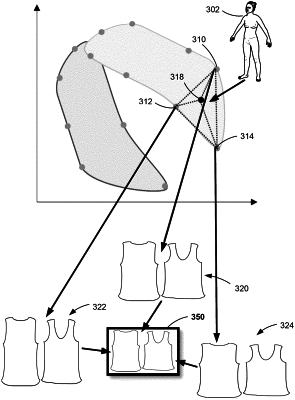| CPC A41H 3/007 (2013.01) [G06F 30/10 (2020.01); G06F 2111/02 (2020.01); G06F 2111/16 (2020.01)] | 18 Claims |

|
1. A system comprising:
a non-transitory data store that stores initial representations of three-dimensional (“3D”) body data of each of a plurality of human bodies; and
at least one computing device configured with computer-executable instructions that, when executed, cause the at least one computing device to:
based at least in part on the initial representations, learn an embedding function that represents an input 3D human body in a lower-dimensional embedding space, wherein proximity between two or more individual bodies represented within the lower-dimensional embedding space corresponds with similarity of body shapes of the two or more individual bodies;
apply the embedding function to a first set of the initial representations to generate a first set of lower-dimensional human body representations;
select a set of reference bodies, wherein the set of reference bodies are selected as a subset of the first set of lower-dimensional human body representations and span at least a majority of the lower-dimensional embedding space that is populated by the first set of lower-dimensional human body representations;
obtain, for each individual reference body in the set of reference bodies, a garment pattern defining an instance of a garment with dimensions sized to fit the individual reference body;
store, in an electronic data store, an association between each of a plurality of obtained garment patterns for the garment and a corresponding reference body;
receive an indication that a user is interested in purchasing a custom-tailored version of the garment;
receive data defining a 3D representation of the body of the user;
generate a lower-dimensional embedding of the 3D representation of the body of the user using the embedding function;
select two or more reference bodies with respect to the user, wherein the two or more reference bodies are selected based on distances from the two or more reference bodies to the lower-dimensional embedding of the 3D representation of the body of the user within the lower-dimensional embedding space;
retrieve, from the electronic data store, reference garment patterns associated with each of the two or more reference bodies selected with respect to the user; and
generate a custom garment pattern for producing the custom-tailored version of the garment for the user, wherein the custom garment pattern is generated at least in part by performing interpolation of garment parameters among the reference garment patterns.
|